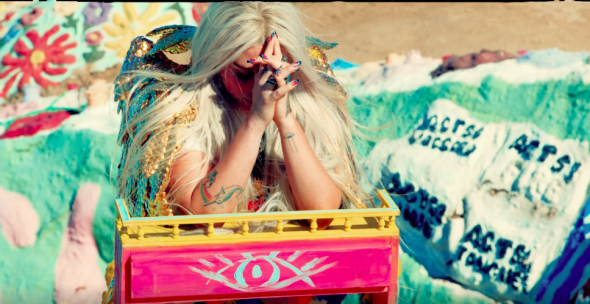Kesha has spent the last three years mired in a legal standoff with her ex-producer, Dr. Luke, whom she’s accused of sexual assault and emotional abuse. Her contract stipulated that she couldn’t make any more music unless it was with him, but she refused to work with a man whom she alleges tormented and manipulated her for years. The court system repeatedly ruled in his favor, leaving her career at a standstill.
On Thursday, she finally emerged with new material, a ballad about survival and healing that clearly draws on her hardships with Dr. Luke, the courts, and dealing with trauma in the public eye. The song, “Praying,” opens with an internal monologue that verges on the suicidal. “If there is a God or whatever, something, somewhere, why have I been abandoned by everyone and everything I’ve ever known, I’ve ever loved?” Kesha asks. “God, give me a sign, or I have to give up. I can’t do this anymore. Please just let me die. Being alive hurts too much.”
In an essay for Lenny Letter published with the “Praying” video debut, Kesha writes that finding spiritual solace—not with “a bearded man sitting in the clouds or a judgmental, homophobic tyrant waiting to send everyone to eternal damnation,” but with “nature and space and energy and the universe”—helped her move forward.
So it’s fitting that the video for “Praying” is full of religious signifiers, placed without concern for relevance or continuity. Kesha plays mournful piano in angel wings, a scaly mermaid-looking suit, and a crown of thorns; later, she kneels at a candlelit altar in front of a neon cross and prays with an open eye drawn on her forehead. There’s a recurring scene with a wall of TVs painted with words and phrases (“you’re too thin,” “the television will not be revolutionized,” “weapons of mass deception”) that make vague reference to cultural coercion and overconsumption, implying a different kind of modern religion. The title cards are written in a font that looks like an imitation of Hindi script, and when the song reaches its climax, Kesha throws around the kind of colored powder people use at Holi, the Hindu festival celebrating the end of winter and the triumph of good over evil. At the end, she literally walks on water, à la Jesus Christ.
The video’s haphazard use of religious symbolism—is she really supposed to be a savior figure?—confuses the thrust of the song, which is a pretty straightforward anthem of redemption. “I can thank you for how strong I have become,” Kesha sings, “’Cause you brought the flames and you put me through hell / I had to learn how to fight for myself.” Marks of transformation abound: The butterflies on her veil, the rainbows on her nails, and her seeming resurrection from a left-for-dead survivor of a terrible boating accident to a mystical deity all speak to Kesha’s vision for her new album as a kind of rebirth. Her album, out August 11, is called Rainbow, too. Most of the video takes place in a kind of psychedelic junkyard that might have been dreamed up by a visionary or outsider artist, delivering a raw product of grief processed into hope, something Kesha had to get out of her in order to salvage her self.
“This song is about coming to feel empathy for someone else even if they hurt you or scare you,” Kesha writes in her Lenny Letter piece. “It’s a song about learning to be proud of the person you are even during low moments when you feel alone. It’s also about hoping everyone, even someone who hurt you, can heal.” It might be too much to say she’s pardoned Dr. Luke—“Some say in life you’re gonna get what you give / But some things only God can forgive,” she sings in “Praying.” Even so, she seems to have found a healthy coda to their years of public struggle. Kesha’s ability to record a new album and bare her emotions on a press tour while living with anxiety, depression, and a “relentless” eating disorder is a testament to the strength she says she wants to inspire in others. Her new release has an obvious meaning, but her survival to see another day, write another song, and tell another story says far more.
